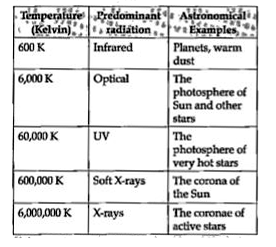What do yo understand by the red shift of a star or of a galaxy of stars
they are gradually receding from the earth
They are gradually approaching the earth
they are stationary
none of these
The correct Answer is:A
Topper's Solved these Questions
Similar Questions
Knowledge Check
On an average a galaxy has stars
A1000 millionB100,000 millionC100 millionD10 millionRead the following text and answer the following questions on the basis of the same:
Spectrum Analysis and Astronomy
Each element in the periodic table can appear in gaseous form and produce its own spectrum unique to that element. Hydrogen will not look like Helium, which wil not look like carbon which will not look like iron....and soon. Astrophysists can identify what kinds of materials are present in stars from the analysis of star's spectra. This type of study is called astronomical spectroscopy. The science of spectroscopy is quite sophisticated. From spectrum lines analysis astrophysists can determine not only the element, but the temperature and density of that element in the star. The spectral line also can tell us about any magnetic field of the star. The width of the line can tell us how fast the material is moving. We can learn about winds in stars from this. The shifting of spectral liens shift back and forth indicates that the star may be orbiting another star. The following table shows a rough guide for the relationship between the temperature of a star and the electromagnetic spectrum.

If the spectrum of a star is red or blue shifted, then it can be used to infer its velocity along the line of sight. Edwin Hubble observed that more distant galaxies tended to have more red shifted spectra. This establishes the theory of expansion of the universe.
From the spectrum analysis the following information of a star can be obtainedAElements present, temperatureBMagnetic field, density, massCdistance of the starDBoth A and B
Why is the distance between stars expressed in light years? What do you understand by the statement that a star Is eight light years away from the earth?
View SolutionWhy is the distance between stars expressed in light years? What do you understand by the statement that a star is eight light years away from the earth?
View SolutionWhy is the distance between stars expressed in light years? What do you understand by the statement that a star is eight light years away from the Earth?
View SolutionWhat do yo understand by magnetic dipole moment of the current loop.
View SolutionWhat does red shift in spectra of galaxies indicate ?
View SolutionA : Universe is expanding
R : There is red shift in the spectra of galaxies
View Solution
